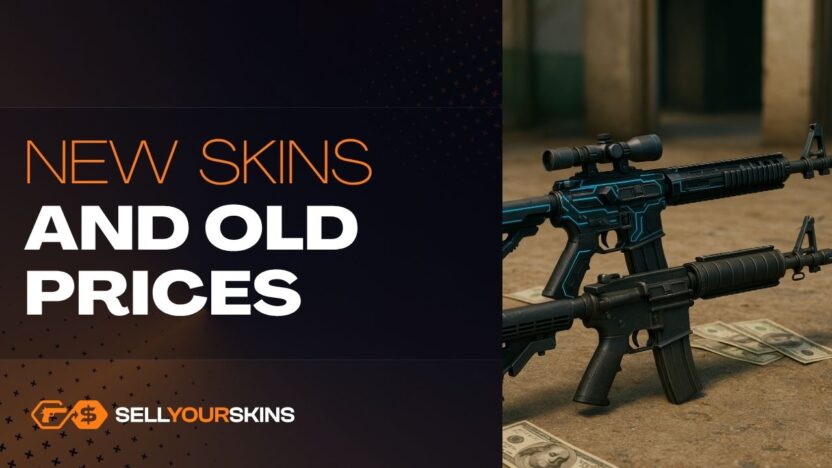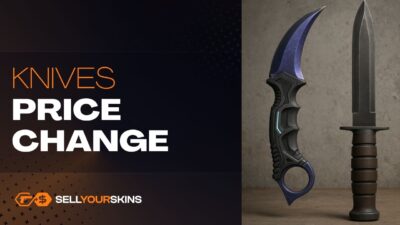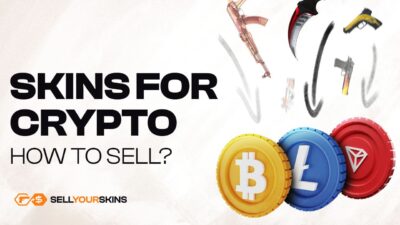New skins appear in CS2 regularly. A natural question arises: does this “dilute” the value of older items? Intuitively, you might think that the more skins enter the market, the less valuable the existing ones become. The reality is a bit more complex. Some groups of skins do lose value due to the influx of new releases, but others – especially rare and iconic ones – can hold their ground or even strengthen their position.
Want to sell your skins for real money? Visit our homepage.
Do New Skins Actually Take Value Away From Old Ones?
Every new case and every new collection introduces visual alternatives for the same weapon types. If an attractive new AK-47 skin appears, some players may stop being interested in older, mediocre looking versions. This works like natural competition: a newer, flashier skin grabs attention, while the older, average looking model gradually loses demand. A drop in demand almost always means a drop in price. However, it’s not true that all old skins lose value – the impact of new items is strongest in the lower segments of the market.
How Oversupply Hurts Cheap and Average Skins
The most vulnerable to price drops are cheap, plain skins with no established reputation. These include all the “filler” items from cases: gray, blue, and some purple skins that stand out neither in appearance, nor rarity, nor trade-up usefulness. When a new case is released with more visually appealing alternatives, players lose any reason to keep old, mediocre skins. As a result, they get sold in large quantities, often at the lowest possible prices, which drags their value down. With the increasing number of new items, such skins have virtually no chance of maintaining their price – they are protected neither by design, nor by rarity, nor by usefulness in trade-ups.
Why Rare and Iconic Skins Handle New Releases Better
The situation looks different for skins that are rare, tied to discontinued cases, or have simply become game icons. Skins from old operation collections, removed maps, or cases that no longer drop often retain their value despite the appearance of newer alternatives. This is due to several solid factors: limited supply, strong recognition within the community, and their “classic” status. Even if a new skin is visually “better,” for some players it cannot replace an old, recognizable design with history behind it. In such cases, the arrival of new skins doesn’t really lower prices – it rather divides the market into new releases and classics.
When Do New Skins Actually Harm Older Ones?
A strong price lowering effect appears when new skins enter the exact niche previously occupied by “premium mid tier” skins. For example: if a new, visually strong M4A4 skin is released in a similar color scheme to an older one that has been on the market for years, the older – yet not iconic – version may lose most of its demand. Players see no reason to pay extra for the “old” model when the new one offers a similar visual effect, often with better execution. In such cases, the older skin becomes an inferior substitute and loses value solely because it gets pushed out of the mainstream by a newer, more appealing competitor.
Is the Skin Market Oversaturated?
The influx of new skins certainly spreads players’ attention across a larger number of items. In that sense, the market does become somewhat “diluted” – especially in the segment of cheap and mid tier skins. The more visually average items there are, the lower the interest in each individual one, which directly translates into lower prices. However, this does not mean that everything old automatically loses value. The market behaves selectively: skins with no personality or history drown in oversupply, while recognizable, rare, and era defining skins often stay in the upper price ranges, barely affected by new releases.
New skins in CS2 can indeed lower the value of older ones, but this mainly applies to cheap, bland items that have no real “advantage” other than simply existing. These are the skins that lose to the influx of newer, better designed alternatives. On the other hand, rare, iconic, and highly recognizable skins often maintain – or even strengthen – their position, protected by limited supply and strong status within the community. You could say that the flood of new skins primarily disrupts the bottom of the market, while the top – well established and highly desirable skins – handles it much more calmly.



